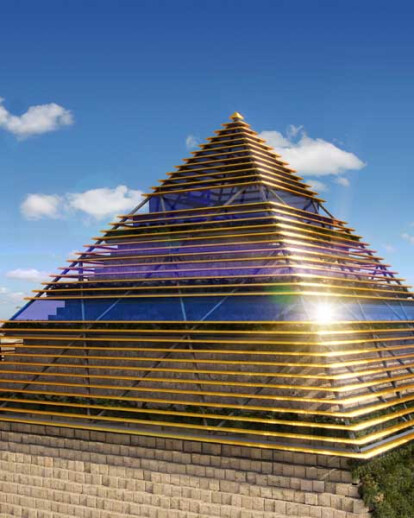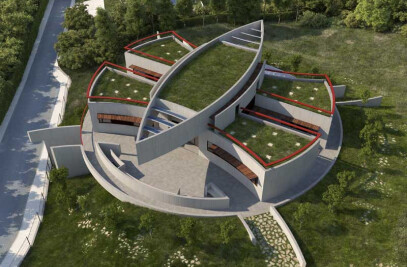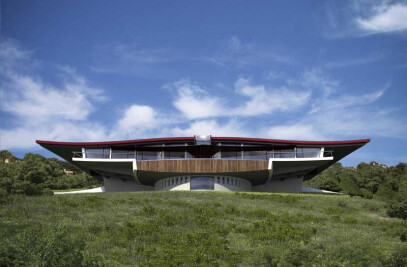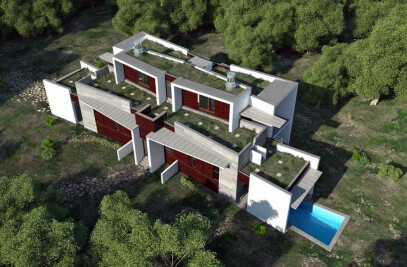Cheops Eco-House is a symbolic, iconic and self-sufficient Museum of human behavior. For this reason it has been dedicated to the prestigious British researcher Richard Wiseman.
Cheops Eco-House is located at the top of the pyramid of Cheops, in Cairo, Egypt. The goal is to build the most important museum in the history of mankind, in the most emblematic place on the planet. As in reality little is known about human behavior, there is little to be displayed in the museum, so that only multimedia equipment and a continuous connection to the global network is needed. Thus, more than a museum, Cheops Eco-House aims to be a unique place for meditation. A place of pilgrimage for all those who want to transcend as humans, and wish to meditate about the future of mankind and the human network on the planet Earth.
Therefore, in reality what has been set out to be built is the world's most iconic building, which is representative of all humans.
Given this responsibility, Cheops Eco-House has been designed using an extensive repertoire of symbolic mathematical proportions:
1. The mathematical proportions (harmonic and cosmic) used in the design of the Great Pyramid of Cheops. 2. The human scale units of measurement (The “elbow” and others) used in the construction of the Great Pyramid of Cheops. 3. The symbolic and mystical relationships used in the design of the Great Pyramid of Cheops.
Cheops Eco-House is perfectly integrated into nature, it has an infinite life cycle, has zero energy consumption, and does not generate waste and emissions. In addition, it can be dismounted at any time, without having a trace and without causing any environmental impact.
The building is self-sufficient in energy, water and food, and perhaps its most striking feature is the large organic garden installed on the entire surface of the east face of the Great Pyramid of Cheops. A garden that ensures the basic supply of food for the occupants of the building and their neighbors.
1. Architectural Solution Cheops Eco-House has pyramidal shape with a square layout (13.9 m. * 13.9 m.), with a height 1/7 of the height of the pyramid of Cheops, and volumetric lines of the original pyramid, before the external limestone blocks had deteriorated and fallen off over time. For this reason a gap between the pyramid and the building has been created, that gives it a strong symbolic character, but at the same time is the reason of its perfect bioclimatic behavior. The building is built by a set of horizontal perimeter strips (slats), made of stainless steel, joined on its inner face by glass panels, shaping a pyramid.
Access to the museum is via a shuttle lift similar to the one used by the Egyptians in the construction of the pyramid of Cheops. The building has a very small living space and has the needed equipment for a family to live comfortably. The goal is that anyone can spend a period of time in the building, with access to all kinds of meta-knowledge that allows them to get to know themselves, transcend as humans, and view their role as part of the future human network.
2. Most important characteristics
1. Self-sufficiency in energy Cheops Eco-House is self-sufficient in energy. That is a connection to the mains is not necessary.
This energy self-sufficiency has been achieved through a set of complementary strategies:
1. An excellent bioclimatic design has been carried out to minimize the need for energy. The pyramid-shaped building, made of stainless steel horizontal slats, creates a stable microclimate inside ensuring the welfare of its occupants. In addition, in the design of building all sorts of bioclimatic strategies have been used to naturally ventilate and thermally self-regulate throughout the year without the need of technologic devices, and therefore without any energy consumption. As a result of its special self-regulating design, the building is cooled by itself in summer and warmed by itself in winter. Similarly, during the day the building is naturally lit, every day of the year, without the use of artificial lighting.
The used bioclimatic strategies have been as follows:
a. Appropriate architectural typology The building is pyramid-shaped made of spaced horizontal slats. The building is placed on the pyramid of Cheops, allowing for a ventilated space in between, which protects the top of the pyramid from solar radiation, and capable of cushioning thermal changes. The building has four faces aligned with the cardinal axes, so that each side can be designed independently in order to take advantage of solar radiation, or achieve the maximum solar protection.
b. Shading The building is formed by horizontal slats that act as sunscreens. These slats are carefully dimensioned, so that in summer, on the south facade, the direct solar radiation does not enter into the building, while in winter the maximum amount enters. Similarly, internal blinds control the indirect solar radiation. There are opaque internal blinds on the east and west side of the building and translucent blinds on the south side. Thus, the building remains naturally lit (by indirect sunlight) without becoming warm. The slats situated on the lower part of the building (2/3 of its height) of the north and south faces are spaced, and the slats located on the top (1/3 of its height) are joined by an internal double glass.
Moreover the slats located in the lower part (2/3 of its height) of the east and west sides are separated by an internal metallic grid that protects the pyramid from solar radiation, and the slats located on the top (1/3 of its height) are joined by an internal double paned high solar reflection glass to protect the building from direct sunlight in the morning and evening.
c. Glass with high insulation capacity The double paned glass used (6-14-4) has a large internal air chamber, and thus a high insulation capacity. Thus, during the winter it keeps the heat (generated by solar radiation and greenhouse effect), and maintains the building warm throughout the day. On the other hand, during the summer it keeps the cool (generated due to the drop in temperature overnight, and low temperatures inside the pyramid of Cheops), and maintains the building cool all day.
d. The greenhouse effect The south facade has a large glass area, which allows the building heated by direct exposure to solar radiation and greenhouse. The greenhouse effect is maximum in winter, but is not generated in summer because the calculated separation between the compositional slats. In winter the building is heated by the greenhouse effect during the day, and the heat builds up in the stone blocks above the apex of the pyramid of Cheops.
e. Natural ventilation The building is naturally ventilated in a continuous manner, through the perimeter space created between the pyramid and the slats of the building. This space continuously generates a volume of warm air, which acts as a heat exchanger, so that the ventilation air enters into the building with a suitable temperature. In summer, the slats create a shaded space that protects the pyramid from solar radiation. Thus the pyramid remains cool (cooled due to the falling temperatures overnight), and refreshes the air pocket between it and the slats. Finally, this cool air enters the building through perimeter vents. In winter, the slats allow solar radiation to enter, which heats the surface layers of the pyramid of Cheops. Thus the pyramid heats the air layer between it and the slats (which protects the layer of air).
f. Removing the hot interior air by means of stack effect. The hot air generated inside the building rises to reach the apex. In this vertex are 8 holes specially designed to allow air to easily pass, but avoids rain from entering. The solar radiation heats the air in the upper housing part (where the glass has no sun protection and no blinds), and therefore rises and creates a suction stream, extracting hot air from the housing, and forcing fresh air from the lower perimeter galleries to enter into the building, and cooling it in its path.
g. Harnessing the night coolness. This is the most efficient mechanism to cool a building in summer. At night, in summer, the surface of the pyramid of Cheops becomes cool (inside remains at an average temperature of 18 º C). The cool night air is introduced into the building, and cools it in its path. The building remains fresh during the next day, because of its high thermal inertia. In a complementary manner, during the day, the slats of the building protect a large area of the top of the pyramid and keep it shaded. Thus the top of the pyramid remains cool throughout the day, so it can cool the building. On the other hand, between the slats and the surface of the pyramid a big pocket of fresh air is created, which is used to ventilate the building continuously.
h. Use of the low temperature inside the pyramid. The interior of the pyramid remains stable at a temperature of about 18 ° C year round. In contrast, the temperature of the surface layer varies according to external temperature changes. Therefore, when the top of the pyramid is covered with the building, an envelope intermediate space is created, shaded, protected and with much less temperature variation. Thus, in summer the building protects the top of the pyramid, so it remains fresh throughout the day, and the building can maintain cool. But in winter the building becomes a huge greenhouse, capable of heating the surface layer of the top of the pyramid, that remains warm during the night, capable of keeping the building warm. Therefore, the building remains cool throughout the summer and warm all winter without technological devices and without any energy consumption.
2. Only essential appliances of very low power consumption have been incorporated in the building. 3. Artificial lighting fixtures OLEDs with very low power consumption were used.
4. A photovoltaic system has been installed to generate the electricity needed for the housing (4,000 watts). The photovoltaic solar captors have been arranged and photovoltaic cells integrated into the stainless steel blades of the south face of the building, and the stained glass of the south face. In addition, a set of next-generation, long lasting electrical batteries have been used, which are capable of storing the electrical energy generated by photovoltaic captors.
5. A set of solar thermal collectors have been integrated into the upper colored glasses on the south side, to generate hot water needs.
6. In the perimeter entries of cool and ventilated air (from perimeter shaded areas between the pyramid and housing) a set of trays have been incorporated, containing silicate salt dehumidifiers. Thus, the cool and ventilated air that enters into the building has a low humidity, thereby improving the thermal sensation (increasing the temperature in winter and decreasing the temperature in summer).
2. Water self-sufficiency Cheops Eco-House is self-sufficient in water. That is, there is no need to connect to the municipal water supply systems.
The water required for human consumption, human hygiene, and to irrigate crops and green areas is obtained from several complementary sources:
1. Groundwater. A hole in the ground has been made next to the pyramid of Cheops, in order to get water from underground aquifers, which can be used directly for irrigation.
2. Rainwater. Rainwater that falls on the pyramid is collected at the bottom of its four sides, and is taken to a buried tank. Much of the rainwater that falls on the eastern face of the pyramid accumulates in the stratum of vegetable growing trays, and drained water is collected at the bottom, partially filtered as it passed through layers of the soil.
Ground water is mixed with rain water and stored in a buried tank with a capacity of 25,000 liters. Most of the stored water is used for drip irrigation of orchards and gardens on the east side, and a small portion of the water is filtered and purified subsequently to become fit for human consumption.
Water purification (for human consumption) is accomplished by a reverse osmosis system with triple membrane (which governs the characteristics of the resulting water by means of an electronic processor), which includes a bacterial system. The resulting water has the same purity and content than mineral water. What's more, the user can choose the mineral content, simply by reprogramming the processor.
3. Greywater recycling. Gray water generated by the building is filtered, treated and stored in an underground reservoir arranged for this purpose. The water thus obtained is mixed with water from underground aquifers and rainwater, and used as biological irrigation of orchards and gardens on the east face of the pyramid.
3. Food self-sufficiency On the east side of the pyramid of Cheops have been arranged several gardens and orchards that provide basic food to the occupants of Cheops Eco-House, and residents of the region.
Every two rows of the pyramid (every row on the bottom) have a set of linear trays filled with farmland, with a drip irrigation system. This way you can easily grow all kinds of food. These foods are trucked to the building through reciprocating hoists of the pyramid. The climate of Egypt, and its fertile land, allows for several crops a year of cereals, fruits and vegetables, legumes, and arable land available is more than enough to feed the building occupants.
4. High bioclimatic level Cheops Eco-House has been designed to have the best bioclimatic behavior possible, and capable of being thermally self regulated. The advanced and highly refined architectural design of the building takes advantage of the huge mass (thermal inertia) of the pyramid, the solar radiation during the day, and the falling temperatures at overnight in Cairo, in order to achieve a building self-sufficient in energy, without the need of technological devices. In fact, due solely to its design, the building is heated by itself in winter and cooled by itself in summer. The building maintains within it a stable comfortable temperature of between about 22 degrees in winter, and 25 degrees in summer.
5. High efficiency and minimum energy consumption Cheops Eco-House has been designed carefully to consume the least amount of energy throughout its life cycle: construction of its components, construction of building (assembling all its components), use, maintenance, and dismantling. Due to its especial bioclimatic design the building has very little need for energy, and the energy it does need can be obtained by its own means from solar radiation, using a minimal amount of technological devices, with a very small economic cost.
6. Complete industrialization All components of Cheops Eco-House have been designed to be manufactured in different factories, and transported to the pyramid for assembly and construction of the building. Of course, this requires a good architectural design to be carried out.
7. Disassemble Construction System The building has been designed to be built using a fully industrialized and disassemble system, which allows all the architectural components to be easily assembled and disassembled. This gives the building an infinite life cycle and allows it to be disassembled and moved as often as you like.
8. Transportability The set of elements of Cheops Eco-House have been designed to be assembled and disassembled easily and indefinitely. For this reason, these elements can be transported to any location, to be easily mounted (in less than a week) as many times as necessary.
9. Extreme Flexibility By design, Cheops Eco-House can be expanded, reduced, or even take on a different architectural configuration. Similarly, its interior open space has been designed to adopt different types of space partitions and reconfigurations, through sliding interior panels.
10. Elimination of waste Cheops Eco-House components have been made in the factory, without generating waste. Similarly, they can be assembled and disassembled without waste generation. This has been achieved through the use of three different strategies: the integral industrialization of all of its components, the design of the assembly system, and compositional design system used on building. Also, organic waste generated during the use of the building are managed optimally and are used to make "compost" to serve as fertilizer for the sloping gardens and orchards of east side. Moreover, the wastewater is properly treated and also used as fertilizer. 11. Infinite life cycle Every component of Cheops Eco-House has been designed to be assembled by means of screws, nails or pressure. This way they can be easily dismounted and removed from the building, to be repaired, reused or returned to the building. Thus, the building can last infinitely, with very low energy consumption. 12. Sloping gardens and orchards On the east side of the pyramid a biological garden, and a sloping garden, have been disposed. The selected plant species are native with low water consumption, and most are edible, medicinal and aromatic. Furthermore, the orchard structure has been formed using a cubic container assembly polypropylene filled with soil. The containers, half a meter wide and two meters long, are located along the inner part of each row of stones of the pyramid, joined together by means of a drip irrigation system, while leaving a passage on outside. Thus, the vegetation completely covers the surface of the pyramid, while leaving space for the harvesting of crops. In this sense, the same system of shuttle lift used for access to the building can be used to explore the east side height of the pyramid, and is helpful for harvesting of crops.
13. Reversible Interior All interior materials of Cheops Eco-House are reversible. That is, they can be removed, retrieved and replaced with ease. All components are assembled by pressure, or screws and therefore can easily be repaired and replaced. This concept extends even to the bathroom fittings and kitchen, toilets and kitchen furniture. 14. Use of environmentally friendly materials Cheops Eco-House uses purely ecological and healthy materials, including new innovative ecological products (insulation made of recycled airplane towels, insulation made of recycled glass, insulation made of glass bottles, panels made of recycled glass, screws, scrap,.... extruded polycarbonate panels, ecological paints, etc.) 15. Promote welfare and happiness It might seem that everyone has different needs and a different concept of happiness. However, from a physical, emotional and psychological standpoint, a set of general patterns can be identified, capable of ensuring the welfare and happiness of people. These patterns have been fully taken into account in the design of Cheops Eco-House, and thus becomes a sounding board, able to promote and increase the happiness of its occupants.
1. Thermal Stability 2. Seasonal temperature variation 2. Natural day lighting 4. Technological simplicity and minimal maintenance 5. Natural materials 6. Architectural design simple and not monotonous 7. Use of the correct colours 8. Sense of security and privacy 9. Beauty 10. Absence of pathogens 11. Breathability 12. Promote human relationships 13. Self-sufficiency (energy, water and food

































